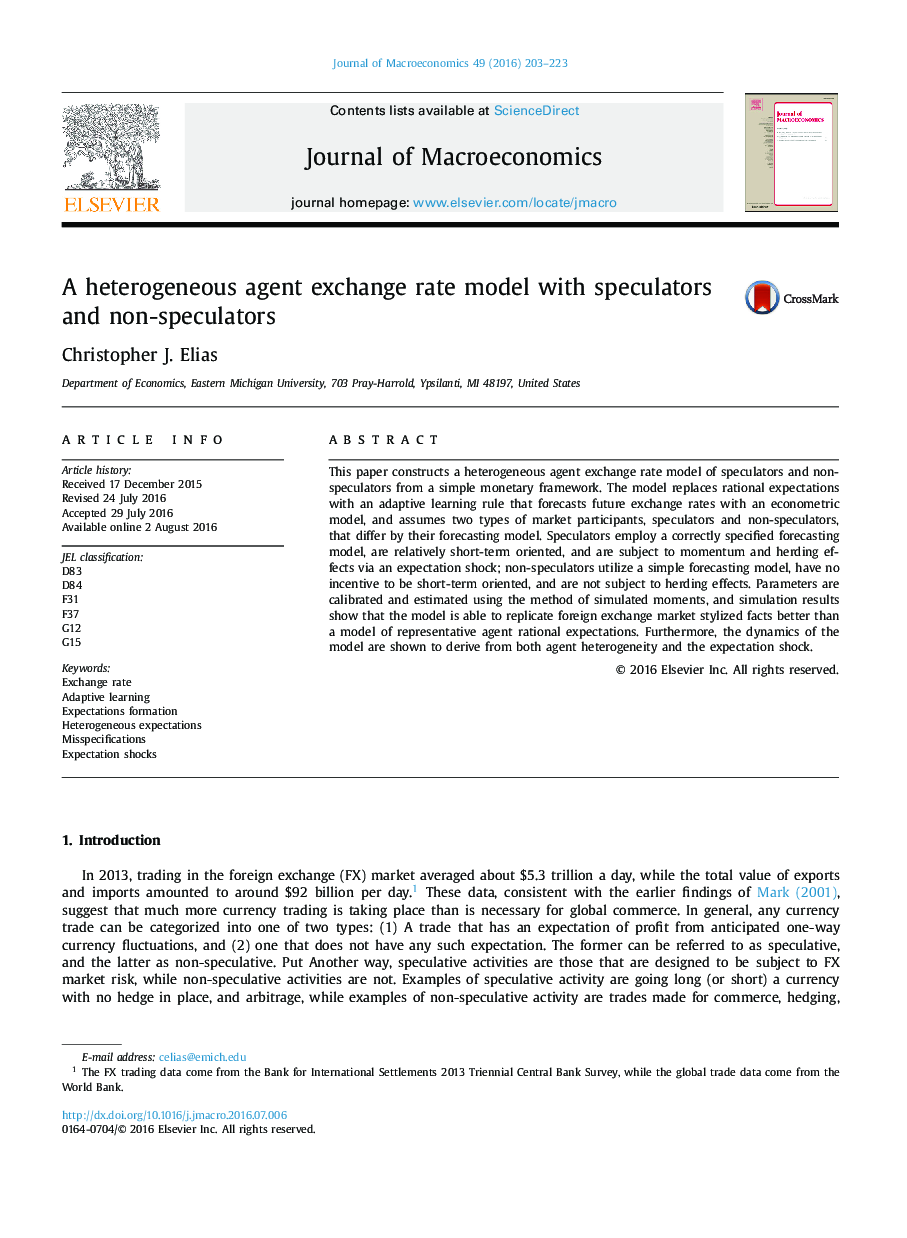| کد مقاله | کد نشریه | سال انتشار | مقاله انگلیسی | نسخه تمام متن |
|---|---|---|---|---|
| 965133 | 1479223 | 2016 | 21 صفحه PDF | دانلود رایگان |
عنوان انگلیسی مقاله ISI
A heterogeneous agent exchange rate model with speculators and non-speculators
ترجمه فارسی عنوان
یک مدل ارز مبادله ناهمگن با دلالان و غیر صلاحیتدار
دانلود مقاله + سفارش ترجمه
دانلود مقاله ISI انگلیسی
رایگان برای ایرانیان
کلمات کلیدی
ترجمه چکیده
این مقاله یک مدل مبادله مبادله ناهمگن سود دلالان و غیر سفته بازان را از یک چارچوب پولی ساده تشکیل می دهد. این مدل جایگزین انتظارات عقلانی با یک قانون یادگیری سازگار می کند که پیش بینی می کند نرخ ارز آینده با یک مدل اقتصادسنجی و دو نوع از مشارکت کنندگان بازار، دلالان و غیر صلاحیتدار، که با مدل پیش بینی آنها متفاوت باشد، جایگزین می شود. مشوقان یک مدل پیش بینی درست و دقیق را به کار می گیرند، نسبتا کوتاه مدت گرا هستند و از طریق شوک انتظاری به اثرات حرکت و تحمل می پردازند؛ غیر سفته بازان از یک مدل پیش بینی ساده استفاده می کنند، هیچ انگیزه ای برای کوتاه مدت گرا ندارند و به اثرات حشرات وابسته نیستند. پارامترها با استفاده از روش لحظات شبیه سازی شده کالیبراسیون شده و برآورد می شوند و نتایج شبیه سازی نشان می دهد که این مدل می تواند حقایق تلطیف شده بازار ارز خارجی را بهتر از یک مدل از انتظارات منطقی عامل نماینده مقایسه کند. علاوه بر این، پویایی مدل نشان می دهد که از هر دو ناهمگنی عامل و شوک انتظار است.
موضوعات مرتبط
علوم انسانی و اجتماعی
اقتصاد، اقتصادسنجی و امور مالی
اقتصاد و اقتصادسنجی
چکیده انگلیسی
This paper constructs a heterogeneous agent exchange rate model of speculators and non-speculators from a simple monetary framework. The model replaces rational expectations with an adaptive learning rule that forecasts future exchange rates with an econometric model, and assumes two types of market participants, speculators and non-speculators, that differ by their forecasting model. Speculators employ a correctly specified forecasting model, are relatively short-term oriented, and are subject to momentum and herding effects via an expectation shock; non-speculators utilize a simple forecasting model, have no incentive to be short-term oriented, and are not subject to herding effects. Parameters are calibrated and estimated using the method of simulated moments, and simulation results show that the model is able to replicate foreign exchange market stylized facts better than a model of representative agent rational expectations. Furthermore, the dynamics of the model are shown to derive from both agent heterogeneity and the expectation shock.
ناشر
Database: Elsevier - ScienceDirect (ساینس دایرکت)
Journal: Journal of Macroeconomics - Volume 49, September 2016, Pages 203-223
Journal: Journal of Macroeconomics - Volume 49, September 2016, Pages 203-223
نویسندگان
Christopher J. Elias,
